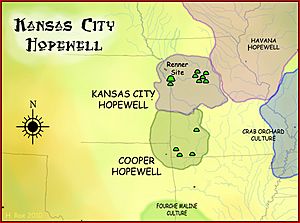Kansas City Hopewell facts for kids
The Kansas City Hopewell were an ancient group of people. They lived in what is now Kansas and Missouri. Their homes were near where the Kansas River meets the Missouri River. They were part of a bigger culture called the Hopewell tradition. This tradition was active during the Middle Woodland period, from about 100 BCE to 700 CE.
Archaeologists have found about 30 places where the Kansas City Hopewell lived. These sites have special pottery and amazing burial mounds. These mounds often contain stone tombs. Scientists are still learning if this culture grew locally or if people from other Hopewell groups moved west and brought their ways with them.
Contents
The Hopewell Trading Network
The Hopewell Exchange system was a huge trading network. It started around 300 BCE in the Ohio River and Illinois River valleys. The Hopewell were not just one single group of people. Instead, they were many different societies who traded with each other.
Their trading routes were very long. For example, archaeologists have found obsidian from the Yellowstone area. They also found copper from Lake Superior. Shells from the Gulf Coast were also traded. These items were found far from where they originally came from. This shows how far the Hopewell people traveled and traded.
Life of the Kansas City Hopewell
Archaeologists divide the Kansas City Hopewell period into three main parts. These parts are based on radiocarbon dates. They also look at how their tools and pottery changed over time.
| Phase | Dates |
|---|---|
| Trowbridge | 1 - 250 CE |
| Kansas City | 250 - 500 CE |
| Edwardsville | 500 - 750 CE |
The Kansas City Hopewell people grew many plants. These included squash and marsh elder. But they also got most of their food from nature. They hunted deer, raccoon, and turkey. They also gathered seeds and nuts. Because they used the rich resources of the oak-hickory forests, they could live in permanent villages.
Important Hopewell Sites
The Renner Village Archeological Site is in Riverside, Missouri. It is one of several important sites near where Line Creek meets the Missouri River. This site shows signs of both Hopewell and later Middle Mississippian people.
The Trowbridge Archeological Site is near Kansas City. It is close to the western edge of the Hopewell trading area. Many "Hopewell"-style pottery pieces and stone tools have been found here. These items are like those found in the Illinois and Ohio river valleys. Decorated Hopewell pottery is rarely found further west than this site.
The Cloverdale archaeological site is near St. Joseph, Missouri. It sits at the mouth of a small valley that opens into the Missouri River Valley. This site shows signs of both Kansas City Hopewell (around 100 to 500 CE) and Steed Kisker (around 1200 CE) people.
Changes Over Time
After 500 CE, the Kansas City Hopewell culture began to change. This time is known as the Late Woodland period. The people started living in smaller groups, often just two or three families. They also began to rely more on farming for their food. These new groups are known as the Central Plains Village culture, specifically the Steed-Kisker Phase.


